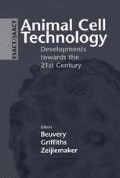Abstract
For the design of production processes with mammalian cell lines not only cultivation strategies but also nutrient requirements and waste production are of particular importance. The determination of the specific uptake rates of all relevant substrates including glucose, glutamine and amino acids is necessary to optimize the feeding rates for processes such as fed batch or perfusion. The concentration of waste products such as ammonium and lactate and other inhibitors also play an important role for growth rate and cell death. Data from a wide variety of cell lines including CHO, mouse hybridomas, rat hybridomas and human lymphocytes were collected and specific uptake rates were calculated and compared.
Access this chapter
Tax calculation will be finalised at checkout
Purchases are for personal use only
Preview
Unable to display preview. Download preview PDF.
References
Büntemeyer H., Lütkemeyer D., Lehmann J. (1991) Optimization of serum-free fermentation processes for antibody production. Cytotechnology 5, 57–67
Eagle H. (1959) Amino acid metabolism mammalian cell cultures. Science 130, 432–437
Ham R.G. (1965) xxxx Proc. Nat. Acad. Sci. 53, 288
Hassel T., Gleave S., Butler M. (1991) Growth inhibition in animal cell culture: The effect of lactate and ammonia. Appl. Biochem. Biotech. 30, 29–41
Heidemann R., Riese U., Lütkemeyer D., Büntemeyer H., Lehmann J. (1994) The Super-Spinner: A low cost animal cell culture bioreactor for the CO2incubator. Cytotechnology 14, 1–9
Hu W.S., Dodge T.C., Frame K.K., Himes V.B. (1987) Effect of glucose on the cultivation of mammalian cells. Dev. Biol. Standard. 66, 279–290
Reitzer L.J., Mice B.M., Kennell D. (1979) Evidence that glutamine, not sugar, is the major energy source for cultured HeLa cells. J. Biol. Chem. 254, 2669–2676
Zielke H.R., Sumbilla C.M., Zielke C.L., Tildon J.T., Ozand P.T. (1984) Glutamine metabolism by cultured mammalian cells. In: Glutamine metabolism in mammalian tissues. I läussinger D. & Sies II. (eds), Springer, Berlin, 247–254
Author information
Authors and Affiliations
Editor information
Editors and Affiliations
Rights and permissions
Copyright information
© 1995 Springer Science+Business Media Dordrecht
About this chapter
Cite this chapter
Büntemeyer, H. et al. (1995). Comparison of Nutrient Requirements of Mammalian Cell Lines. In: Beuvery, E.C., Griffiths, J.B., Zeijlemaker, W.P. (eds) Animal Cell Technology: Developments Towards the 21st Century. Springer, Dordrecht. https://doi.org/10.1007/978-94-011-0437-1_19
Download citation
DOI: https://doi.org/10.1007/978-94-011-0437-1_19
Publisher Name: Springer, Dordrecht
Print ISBN: 978-94-010-4195-9
Online ISBN: 978-94-011-0437-1
eBook Packages: Springer Book Archive

